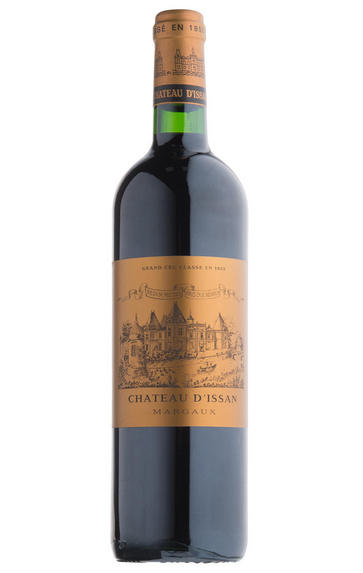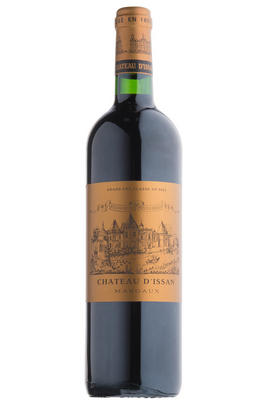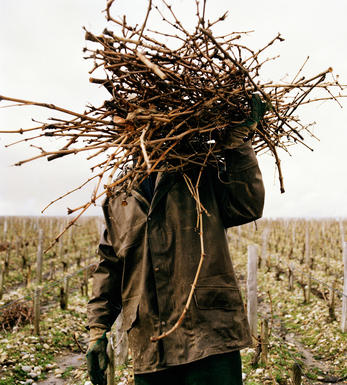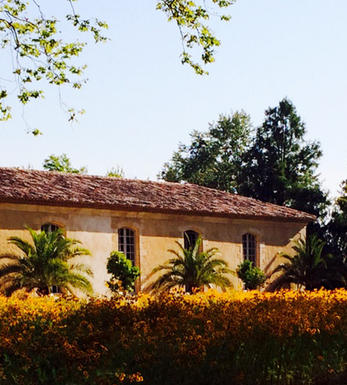
2009 Château d'Issan, Margaux, Bordeaux

Critics reviews
The 2009 d’Issan is endowed with an intense and classically styled bouquet, quite tight at the beginning but opening with black plum and bilberry scents. The palate is medium-bodied with grainy tannin, almost Pauillac in style with graphite-infused black fruit and a long, black pepper and cedar-infused finish. This represents the best showing of the 2009 d’Issan. Excellent. Tasted blind at Farr Vintners’ 2009 Bordeaux tasting.
Drink 2022 - 2045
Neal Martin, Vinous.com (March 2019)
A 60/40 blend of merlot and cabernet sauvignon; 13.9% alcohol; ITP 72; pH 3.81.
Very dark ruby, with black highlights. The nose is distinctly stricter and more austere than usual for this wine, with fresh blackcurrant, violet and cedar aromas nicely lifted by a mineral note. It enters bright and fresh, with lively acids framing the sweet black fruit flavours well. The long, clean, vibrant finish features building tannins that are youthfully aggressive and chewy.
This very attractive, classically styled Bordeaux wine eschews overripe aromas and jammy fruit flavours and is very much Margaux in style and weight. Although it will need considerable time to resolve its tannins and open fully, it should appeal to those who prefer Bordeaux's daintier, higher-acid style. Forget about it in your cellar for about ten years, then enjoy it for another 20 after that.
Ian D'Agata, Vinous.com (May 2010)
Rich, silky, concentrated, hugely powerful and young still, rippling with black chocolate and tight, firm tannins. This is barely getting going; you can still see and feel the walls of the wine. It's brilliant, with the Issan touch and typicity, if not as effortless as the 2005 at this stage. You can drink now, but it will benefit from a few more years, and it should be decanted if you are going for it soon. Hail as in 2008, meaning a yield of 35hl/ha.
Drink 2020 - 2045
Jane Anson, Decanter.com (December 2019)
A strong effort from proprietor Emmanuel Cruse, d’Issan’s 2009 was fashioned from minuscule yields of 18 hectoliters per hectare, and its 13.7% natural alcohol set a record at this estate. Composed of 62% Cabernet Sauvignon and 38% Merlot, it exhibits a classic Margaux fragrance of acacia flowers/violets, blueberries, cassis, liquorice and camphor. Opulent and full-bodied with silky tannins and a rich, dense style, it will be interesting to compare the 2009 with the brilliant 2000 and 2005 over the next two to three decades.
Anticipated maturity: 2018 - 2035+
Robert M. Parker, Jr., Wine Advocate (December 2011)
Tasted blind. Mid-crimson with a mature rim. A rich nose that is just the right side of porty. Lots to like, and very definitely a 2009! Rich and satisfying.
Drink 2020 - 2035
Jancis Robinson MW, JancisRobinson.com (March 2019)
Noble aromatics of freshly cut herbs, dewy meadow grass, white flower, cassis and tobacco leaf signify a wine of finesse, with balancing acidity and showy brightness for a 2009. It is still quite youthful, with noticeable tannins, indeed tasting younger than its age—gorgeous freshness on the finish.
Drink 2022 - 2045
Panos Kakaviatos, Decanter.com (April 2022)
Bright medium ruby-red. Wild aromas of redcurrant, blueberry, mocha, smoke and game. It is very rich and full for Margaux if a bit youthfully monolithic today following its silky entry, with black fruit flavours accompanied by medicinal chocolate and menthol elements. It has the stuffing and length to support its big, mouth-dusting tannins. Offers impressive potential.
Stephen Tanzer, Vinous.com (July 2012)
About this WINE

Chateau d'Issan
Ch. d`Issan is a Third Growth Margaux property that produces about 100,000 bottles each year. Its richly aromatic and silky-textured Clarets are often amongst the best of the appellation.
The estate’s history dates back to the 1152 when the wine was officially served at the wedding of Eleanor of Aquitaine to King Henry II, the beginning of a special relationship between Bordeaux and England. The d’Essenault family owned the estate over five generations and rebuilt the existing château at the end of the 16th century. Surrounded by a moat, it is one of the oldest châteaux in the region and is frequently described as the most romantic in the Médoc.
In 1945 the Cruse family – already established in the Médoc for more than 150 years – purchased the property. Today Emmanuel Cruse runs the estate with the Lorenzetti family (owners of Chx Pédesclaux and Ladouys). They own 44 hectares in Margaux, planted with 62 percent Cabernet Sauvignon and 38 percent Merlot. The wine spends between 16 and 18 months in oak (around 50 percent new).

Margaux
If Pauillac can be seen as the bastion of ‘traditional’ Red Bordeaux, then Margaux represents its other facet in producing wines that are among Bordeaux’s most sensual and alluring. It is the largest commune in the Médoc, encompassing the communes of Cantenac, Soussans, Arsac and Labaude, in addition to Margaux itself. Located in the centre of the Haut-Médoc, Margaux is the closest of the important communes to the city of Bordeaux.
The soils in Margaux are the lightest and most gravelly of the Médoc, with some also containing a high percentage of sand. Vineyards located in Cantenac and Margaux make up the core of the appelation with the best vineyard sites being located on well-drained slopes, whose lighter soils give Margaux its deft touch and silky perfumes. Further away from the water, there is a greater clay content and the wines are less dramatically perfumed.
Margaux is the most diffuse of all the Médoc appelations with a reputation for scaling the heights with irreproachable wines such as Ch. Margaux and Ch. Palmer, but also plumbing the depths, with too many other châteaux not fulfilling their potential. There has been an upward shift in recent years, but the appellation cannot yet boast the reliability of St Julien. However, the finest Margaux are exquisitely perfumed and models of refinement and subtlety which have few parallels in Bordeaux.
Recommended Châteaux: Ch. Margaux, Ch. Palmer, Ch. Brane-Cantenac, Ch. Rauzan-Ségla , Ch. Dufort-Vivens, Ch. Ferrière, Ch. du Tertre, Ch. Giscours, Ch. d'Angludet.

Cabernet Sauvignon Blend
Cabernet Sauvignon lends itself particularly well in blends with Merlot. This is actually the archetypal Bordeaux blend, though in different proportions in the sub-regions and sometimes topped up with Cabernet Franc, Malbec, and Petit Verdot.
In the Médoc and Graves the percentage of Cabernet Sauvignon in the blend can range from 95% (Mouton-Rothschild) to as low as 40%. It is particularly suited to the dry, warm, free- draining, gravel-rich soils and is responsible for the redolent cassis characteristics as well as the depth of colour, tannic structure and pronounced acidity of Médoc wines. However 100% Cabernet Sauvignon wines can be slightly hollow-tasting in the middle palate and Merlot with its generous, fleshy fruit flavours acts as a perfect foil by filling in this cavity.
In St-Emilion and Pomerol, the blends are Merlot dominated as Cabernet Sauvignon can struggle to ripen there - when it is included, it adds structure and body to the wine. Sassicaia is the most famous Bordeaux blend in Italy and has spawned many imitations, whereby the blend is now firmly established in the New World and particularly in California and Australia.


Buying options
Add to wishlist
Description
The 2009 d’Issan is endowed with an intense and classically styled bouquet, quite tight at the beginning but opening with black plum and bilberry scents. The palate is medium-bodied with grainy tannin, almost Pauillac in style with graphite-infused black fruit and a long, black pepper and cedar-infused finish. This represents the best showing of the 2009 d’Issan. Excellent. Tasted blind at Farr Vintners’ 2009 Bordeaux tasting.
Drink 2022 - 2045
Neal Martin, Vinous.com (March 2019)
wine at a glance
Delivery and quality guarantee